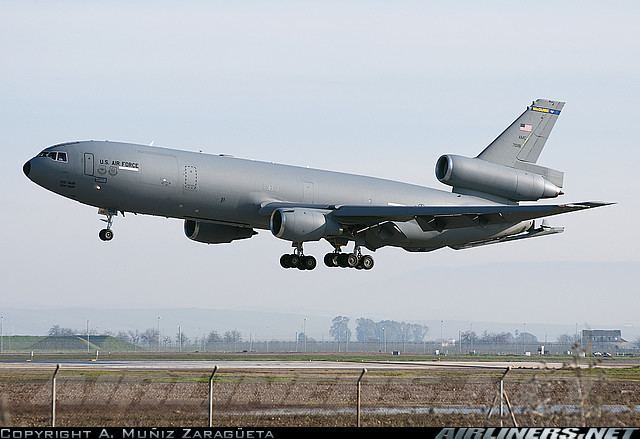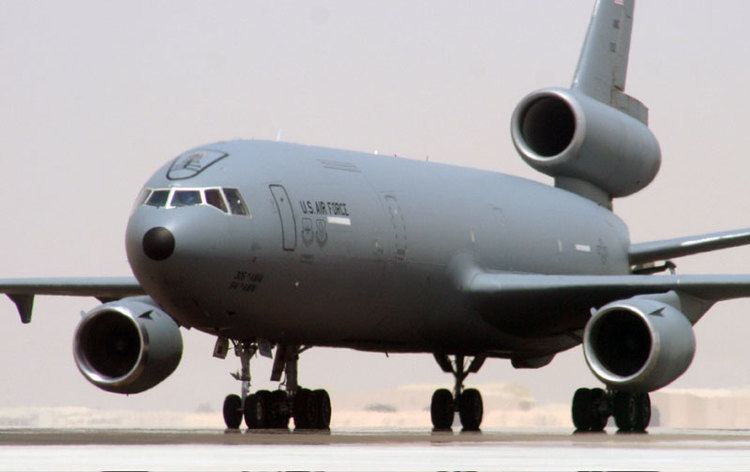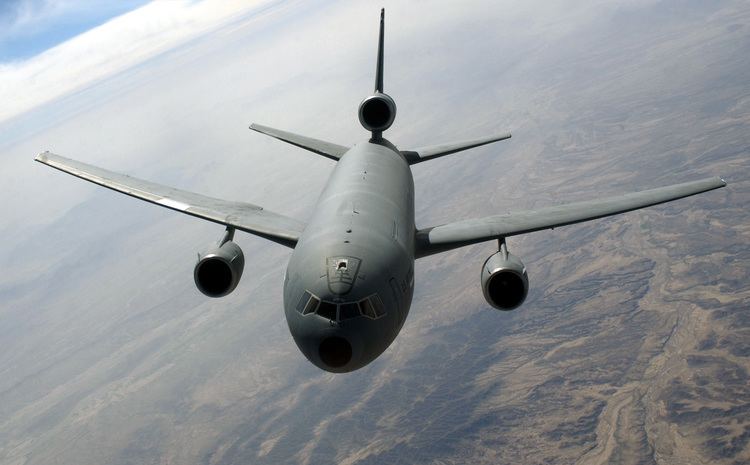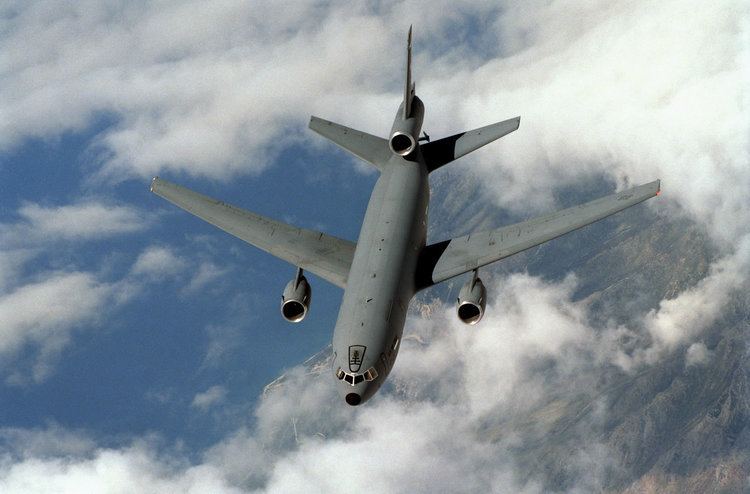Fuel capacity 197,800 L Top speed 996 km/h Range 7,032 km | Wingspan 50 m Length 55 m Engine type General Electric CF6 | |
 | ||
Unit cost 88,400,000–88,400,000 USD (1998) | ||
Mcdonnell douglas kc 10 extender refueling aircraft 3d model
The McDonnell Douglas KC-10 Extender is an aerial refueling tanker aircraft – the military version of the three-engined DC-10 airliner - operated by the United States Air Force (USAF). The KC-10 was developed from the Advanced Tanker Cargo Aircraft Program. It incorporates military-specific equipment for its primary roles of transport and aerial refueling. It was developed to supplement the KC-135 Stratotanker following experiences in Southeast Asia and the Middle East. The KC-10 was the second McDonnell Douglas transport aircraft to be selected by the Air Force following the C-9. A total of 60 KC-10s were produced for the USAF. The Royal Netherlands Air Force operates two similar tankers designated KDC-10 that were converted from DC-10s.
Contents
- Mcdonnell douglas kc 10 extender refueling aircraft 3d model
- Mcdonnell douglas kc 10 extender air refueling
- Advanced Tanker Cargo Aircraft Program
- KC 10 Extender
- Further developments
- United States
- Netherlands
- Civilian operators
- Operators
- Incidents
- Specifications KC 10A
- References

The KC-10 plays a key role in the mobilization of US military assets, taking part in overseas operations far from home. These aircraft performed airlift and aerial refueling during the 1986 bombing of Libya (Operation Eldorado Canyon), the 1990–91 Gulf War with Iraq (Operations Desert Shield and Desert Storm), the NATO bombing of Yugoslavia (Operation Allied Force), War in Afghanistan (Operations Enduring Freedom), and Iraq War (Operations Iraqi Freedom and New Dawn). The KC-10 is expected to serve until 2043.

Mcdonnell douglas kc 10 extender air refueling
Advanced Tanker Cargo Aircraft Program

During the Vietnam War, doubts began to be raised regarding the Boeing KC-135 Stratotanker fleet's ability to meet the needs of the United States' global commitments. The aerial refueling fleet was deployed to Southeast Asia to support tactical aircraft and strategic bombers, while maintaining the U.S.-based support of the nuclear-bomber fleet. Consequently, the Air Force sought an aerial tanker with greater capabilities than the KC-135. In 1972, two DC-10s were flown in trials at Edwards Air Force Base, simulating air refuelings to check for possible wake issues. Boeing performed similar tests with a 747.

During the 1973 Yom Kippur War, the Air Force commenced Operation Nickel Grass to supply Israel with weapons and supplies. The operation demonstrated the necessity for adequate air-refueling capabilities; denied landing rights in Europe, C-5 Galaxy transports were forced to carry a fraction of their maximum payload on direct flights from the continental United States to Israel. To address this shortfall in mobility, in 1975, under the Advanced Tanker Cargo Aircraft Program, four aircraft were evaluated –– the Lockheed C-5, the Boeing 747, the McDonnell Douglas DC-10, and the Lockheed L-1011. The only serious contenders were Boeing and McDonnell Douglas. On 19 December 1977, McDonnell Douglas's DC-10 was chosen. The primary reason of this choice was the KC-10's ability to operate from shorter runways. Initially, a batch of 12 aircraft was ordered, but this was later increased to 60.
KC-10 Extender

The KC-10 Extender first flew on 12 July 1980, but it was not until October the same year that the first aerial refuel sortie was performed. The design for the KC-10 involved modifications from the DC-10-30CF design. Unnecessary airline features were replaced by an improved cargo-handling system and military avionics. Meanwhile, the KC-10 retains 88% commonality with its commercial counterparts, giving it greater access to the worldwide commercial support system. Other changes from the DC-10-30CF include the removal of most windows and lower cargo doors. Early aircraft featured a distinctive light gray, white and blue paint scheme, but a gray-green camouflage scheme was used on later tankers. The paint scheme was switched to a medium gray color by the late 1990s.
The most notable changes were the addition of the McDonnell Douglas Advanced Aerial Refueling Boom (AARB) and additional fuel tanks located in the baggage compartments below the main deck. The extra tanks increase the KC-10's fuel capacity to 356,000 lb (161,478 kg), nearly doubling the KC-135's capacity. The KC-10 has both a centerline refueling boom — unique in that it sports a control surface system at its aft end that differs from the V-tail design used on previous tankers — and a drogue-and-hose system on the starboard side of the rear fuselage. The KC-10 boom operator is located in the rear of the aircraft with a wide window for monitoring refueling. The operator controls refueling operations through a digital fly-by wire system. Unlike the KC-135, the KC-10's hose-and-drogue system allows refueling of Navy, Marine Corps, and most allied aircraft, all in one mission. The final twenty KC-10s produced included wing-mounted pods for added refueling locations. In addition to its tanking role, the KC-10 can carry a complement 75 personnel with 146,000 lb (66,225 kg) of cargo, or 170,000 lb (77,110 kg) in an all-cargo configuration. The KC-10 has a side cargo door for loading and unloading cargo. Handling equipment is required to raise and lower loads to the cargo opening.
Further developments
A need for new transport aircraft for the Royal Netherlands Air Force (Koninklijke Luchtmacht) was first identified in 1984. The 1991 Gulf War highlighted the deficiencies in mobility of European forces. In 1991 four categories of transport requirements were established. Category A required a large cargo aircraft with a range of at least 4,500 km and the capability to refuel F-16s. In 1992, two DC-10-30CFs were acquired from Martinair in a buy/leaseback contract. When one of the two aircraft was lost in the Martinair Flight 495 crash, a third aircraft was bought from Martinair.
The conversion was handled via the United States foreign military sales program, which in turn contracted McDonnell Douglas. Costs for the conversion were initially estimated at $89.5 million (FY 1994). The aircraft was to be equipped with both a boom and a probe and drogue system. However, because McDonnell Douglas did not have any experience with the requested Remote Aerial Refueling Operator (RARO) system, and because the third aircraft differed from the original two, the program could not be completed at budget. By omitting the probe and drogue system and a fixed partition wall between the cargo and passenger, the cost could be limited at $96 million. To make up for the cost increase McDonnell Douglas hired Dutch companies to do part of the work. The actual converting of the aircraft was done by KLM. Conversion of the aircraft was done from October 1994 to September 1995 for the first aircraft and from February to December 1995 for the second. This was much longer than planned, mostly because McDonnell Douglas delivered the parts late. This would have again increased the cost, but in the contract for the AH-64 Apaches which the Royal Netherlands Air Force also bought from McDonnell Douglas, the price was agreed to be kept at $96 million.
To modernize the KC-10, the USAF has awarded a contract to Boeing in 2010 to upgrade the fleet of 59 aircraft with new communication, navigation, surveillance and air traffic management (CNS/ATM) system. This was to allow the aircraft to fly in civil airspace as new ICAO and FAA standards took effect in 2015. Rockwell Collins was also awarded a contract in 2011 for avionics and systems integration for the cockpit modernization program.
United States
The first KC-10s was delivered to the Air Force's Strategic Air Command (SAC) in March 1981 at Barksdale AFB; the 60th and final KC-10 arrived on 29 November 1988. The KC-10s served with SAC until 1992, when they were reassigned to the newly established Air Mobility Command. In the aerial refueling role, the KC-10s have been operated largely in the strategic refueling of large number of tactical aircraft on ferry flights and the refueling of other strategic transport aircraft. Conversely, the KC-135 fleet has operated largely in the in-theater tactical role. There are 59 KC-10 Extenders in service with the USAF as of 2010. The USAF's KC-10s are stationed primarily at Travis AFB, California, and Joint Base McGuire-Dix-Lakehurst formerly known as McGuire AFB, New Jersey.
When faced with refusals of basing and overflight rights from continental European countries during Operation El Dorado Canyon, the U.S. was forced to use the UK-based F-111s in the 1986 air-strikes against Libya. The KC-10s and KC-135s allowed 29 F-111s, along with other Air Force and Navy aircraft, to reach their targets. The KC-10 again played a key role during Operations Desert Shield and Desert Storm in 1991; KC-10s facilitated the deployment of tactical, strategic, and transport aircraft to Saudi Arabia. In the early stages of Operation Desert Shield, aerial refueling was key to the rapid airlift of materiel and forces. In addition to refueling airlift aircraft, the KC-10, along with the smaller KC-135, moved thousands of tons of cargo and thousands of troops in support of the massive buildup. The KC-10 and the KC-135 conducted about 51,700 separate refueling operations and delivered 125 million gallons (475 million liters) of fuel without missing a single scheduled rendezvous.
Since then, the KC-10 had participated in other smaller conflicts. In March 1999, NATO launched Operation Allied Force against the government of Yugoslavia. The mobility portion of the operation began in February and was heavily dependent on tankers. By early May 1999, some 150 KC-10s and KC-135s deployed to Europe where they refueled bombers, fighters and support aircraft engaged in the conflict. The KC-10 flew 409 missions throughout the entire Allied Force campaign and continued support operations in Kosovo. Since 11 September 2001, KC-10s had also flown more than 350 missions guarding U.S. skies as a part of Operation Noble Eagle. During Operations Enduring Freedom and Iraqi Freedom, KC-10s have flown more than 1,390 missions delivering critical air refueling support to numerous joint and Coalition receiver aircraft. KC-10s are expected to serve until 2043.
The Air Force considered retiring its fleet of KC-10 tankers in response to sequestration budget cuts as part of the service's FY 2015 budget. A "vertical chop" to divest all KC-10s was suggested because there are fewer KC-10s than KC-135s, having three different tanker models in service (after the introduction of the KC-46) would be costly, and a "horizontal cut" across the refueling fleets would achieve small efficiencies. Some believed retiring the KC-10 would not benefit the Air Force, given that it is equipped with both boom and hose-and-drogue refueling systems and the fleet's relatively young age. At first, officials claimed that the initial focus on retiring the KC-10 in September 2013 was a "trial balloon" to call attention to Air Force operating cost issues; as of early 2013, the KC-10 had a per hour flying cost of $21,170 and a mission capable rate of 87 percent. A FY 2015 budget plan did not include cuts to the KC-10.
The KC-10 uniquely has the ability to act as a cargo aircraft and a tanker on overseas deployments of fighters by carrying the fighter support personnel and equipment while simultaneously refueling the fighters.
Netherlands
The two Dutch KDC-10s are used for both refueling and transport. They are stationed on Eindhoven Airport as part of the 334th Transport Squadron. Of the 5,500 hours flown in the first 3 years of use, the aircraft were used in their tanker role for 50% of the time. Besides being used by the air force and NATO allies, the KDC-10s are also used to support peacekeeping and humanitarian aid operations. Of the first three years, 32% of the flight hours were used for peacekeeping and humanitarian aid.
In this function, the aircraft have been deployed to Kosovo to evacuate refugees, to the Caribbean and Central America to provide humanitarian aid after the hurricanes Luis, Georges and Mitch and to various countries in Africa and Asia to provide development aid. In 1998, the aircraft were also used to evacuate Dutch citizens from Indonesia during the Fall of Suharto. Dutch KDC-10s have been operating out of Manas AFB in support of allied forces during Operation Enduring Freedom.
Civilian operators
Commercial refueling companies Omega Aerial Refueling Services and Global Air Tanker Service operate two KDC-10 tankers (N974VV and N852V, respectively) for lease. They were converted from DC-10-40s and provide probe and drogue refueling capabilities from wing pods similar to the KC-10. In June and July 2011, Omega Air's KDC-10 supported 3 of Royal Australian Air Force's F/A-18 Hornets, en route to Red Flag – Alaska.
Operators
United States Air Force – 59 KC-10 aircraft in use as of September 2012.
Strategic Air CommandAir Force Reserve Command
Incidents
On 17 September 1987, KC-10A serial number 82-0190 was undergoing maintenance on the ground at Barksdale AFB, Louisiana and suffered an explosion and subsequent fire. The KC-10 was significantly damaged and written-off. One member of the ground crew, Sgt. Joseph M. Burgio died in the fire.
Specifications (KC-10A)
Data from USAF Fact sheet, Steffen
General characteristics
Performance
